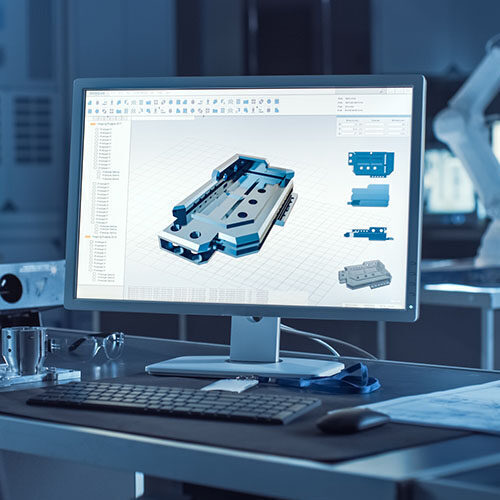
Current Trends in Manufacturing
Manufacturers have had a whole lot to deal with in 2021, and 2022 is shaping up to be the same.
The good news: the manufacturing industry, with the exception of a few sectors, is booming, and the growth experienced in the industry over the last year is forecasted to continue throughout 2022 and into 2023. Many manufacturers are dealing with record-setting orders, which will keep them busy well into the next calendar year.
The bad news: all of this growth is not necessarily translating into increased profits within the industry. Unfortunately, supply chains continue to be a major source of strife within the industry. This, along with the ongoing labor shortage in the industry, is driving costs up for many manufacturers. The industry as a whole — with small to mid-sized manufacturers feeling it the most — will continue to grapple with these issues in 2022.
What Trends Can We Expect in Manufacturing for 2022?
Supply Chain Problems
Supply chains continue to be one of the biggest challenges facing manufacturers in 2022. Covid-related disruptions and increased demand have created bottlenecks in the global supply chain. While we wish there was better news on the horizon, record-long lead times for raw materials, shortages of goods, and increased prices will continue to be the new normal in 2022.
Manufacturers can improve operational efficiency and refine their purchasing and inventory management practices, but most will have to pass on higher costs to their customers.
Some manufacturers are also ditching their just-in-time inventory management practices in favor of just-in-case stockpiling to try to ensure that raw materials will be on-hand when needed for production. All-in-all manufacturers will spend more time sourcing materials — and waiting for them to arrive — in 2022.
Labor Shortages (Plus Training Issues)
Labor shortages have plagued the manufacturing sector for years, but the pandemic has pushed the labor shortage to a crisis point. Manufacturers across the globe are reporting all-time high labor shortages with an urgent need for both skilled and unskilled workers. Many manufacturers believe that labor shortages will cause them to reduce their output as they do not have enough workers to run their shops at capacity.
Some manufacturers have been able to fill vacant positions by poaching workers from other industries that have been hit hard by the pandemic, such as the restaurant and hospitality industries, as workers from these sectors seek out more stable jobs. But this leads to another problem for manufacturers: how to train new employees to get them up-to-speed quickly.
Manufacturers who can find better, faster, and cheaper ways to train staff will come out ahead. Better and more efficient training will allow manufacturers to fill job vacancies and get new employees — including those from other industries — prepared and able to take on their new roles.
Trade Policy Issues
The international trade waters are turbulent these days — and will most likely remain so for the foreseeable future. Trade agreements, trade wars, trade disputes, and tariffs will continue to create an air of unpredictability for manufacturers. Trade policies and global tension will continue to be something manufacturers need to keep an eye on in 2022.
Digital Transformation
It’s safe to say that Industry 4.0 is well underway. A push towards greater digital technologies has been afoot for years now, but the pandemic has pushed digital transformation within the manufacturing industry into overdrive.
Digital transformation is the adoption of digital technologies in all areas of an organization to transform how a manufacturing company operates. The manufacturing industry is seeing a huge uptick in digitization, automation, and inter-connectivity. Other factors such as the emergence of better analytics and business intelligence capabilities, advances in artificial intelligence, and the continued development of the internet of things (IoT) are also driving the change.
Digital transformation leverages technology to make manufacturers more streamlined and more effective. Embracing new digital technology will be an important feature in determining which manufacturers emerge from this time strong and competitive — and which companies lag behind.
Manufacturers that haven’t developed a digital transformation strategy should start right now before their hands are forced, and decisions are rushed. While all manufacturers must embrace new technologies, building the right foundation and making smart decisions that will help manufacturers now, and in the years to come, is important.
RELATED ARTICLE: ERPs Help Manufacturers Harness the Power of Big Data and Embrace Industry 4.0
Re-Shoring
Re-shoring, or the moving of manufacturing facilities and jobs back home, is another trend that has been consistently underway over the past few years and is being given a big boost by the pandemic.
Beset with shortages and supply chain issues, many governments, including across North America and Europe, are investing money into bringing manufacturing operations back onto their soil. The disruptions to supply chains brought by the pandemic have shown just how much the United States and Canada (and European countries) rely on foreign nations for their manufactured goods — and have added a degree of urgency to beefing up manufacturing close to home.
Expect continued government incentives to draw manufacturing operations back home and to help build a more resilient local supply chain network.
Climate Change
Though often overshadowed by the pandemic, climate change continues to be a force shaping the manufacturing industry in 2022.
Manufacturing has long been one of the most significant contributors to environmental pollution: for example, the steel industry alone is responsible for 7–9% of global CO2 emissions. Things need to change within the industry, and that change needs to come now.
2022 will see some manufacturers start to take tangible steps towards reducing their impact on the environment with electrification, better energy and resource management, and some early attempts to begin changing customer behavior and expectations. To help promote the green economy, governments will continue to offer grant money and rebates to manufacturers that are committed to reducing their environmental impact.
Conclusion
Even with the industry booming, it may not feel like it is a great time to be a manufacturer. The past two years have been trying times for manufacturers, and 2022 is shaping up to be another challenging year.
Manufacturers need to be smart — and use the best tools available to help them manage these uncertain times. Making smart decisions now, and preparing for the future, will help manufacturers succeed in 2022 and beyond.
Get your eBook Scared to implement a new ERP?
"*" indicates required fields



